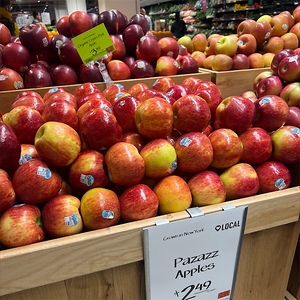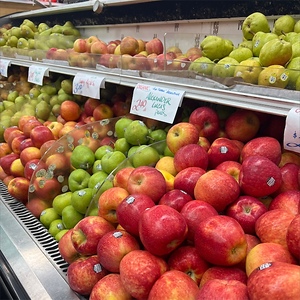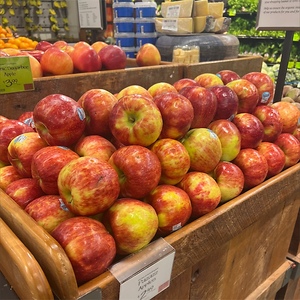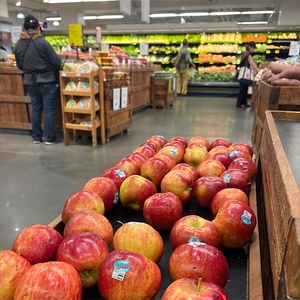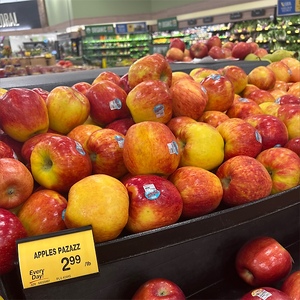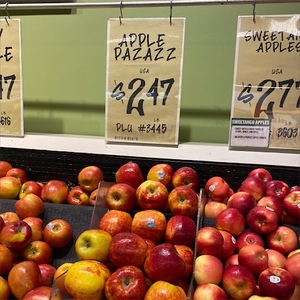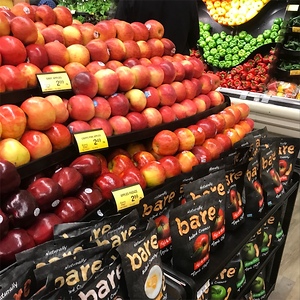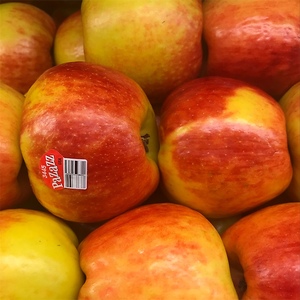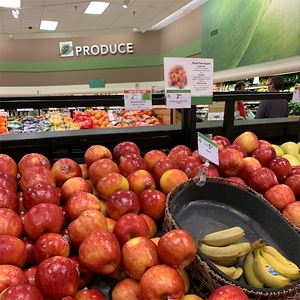

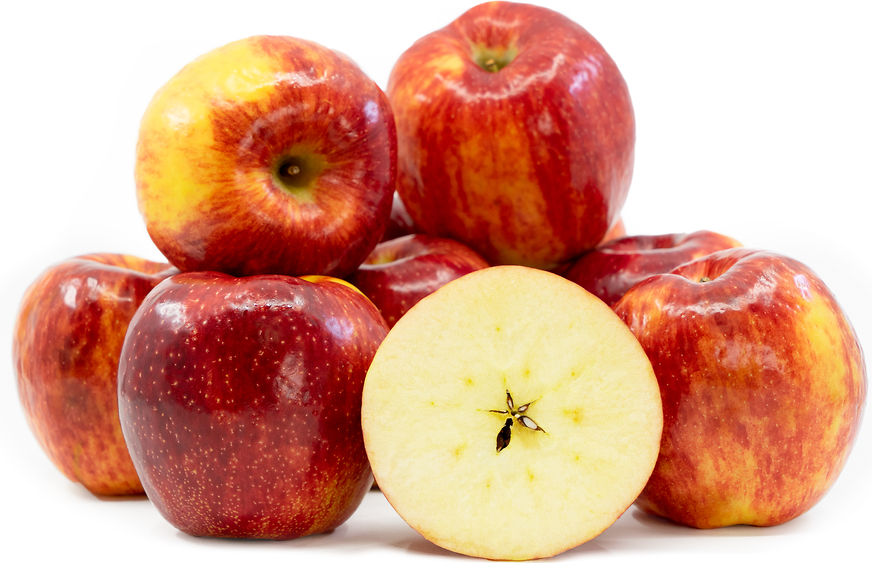
Pazazz Apples
Estimated Inventory, lb : 0
Description/Taste
Pazazz apples are a medium to large varietal, averaging 8 to 9 centimeters in diameter, and have a round to conical appearance with flat, blocky shoulders tapering to a narrow, sometimes slanted base. The apple's skin is smooth, semi-thick, glossy, and taut, showcasing prominent pale yellow lenticels across the surface. The skin also has a vibrant golden yellow base hue, covered in large patches of bright to dark red blush with mottled, broken striping. The blush will vary per apple depending on the amount of sun exposure during cultivation. Underneath the surface, the ivory-to-pale yellow flesh is firm, aqueous, and dense with a crisp, crunchy consistency. The flesh also encases a small central core filled with tiny, black-brown seeds. Pazazz apples have high acidity and sugar levels, contributing to the flesh's sweet, tart, and tangy taste.
Seasons/Availability
Pazazz apples are harvested in the fall and can be stored through the early spring.
Current Facts
Pazazz apples, botanically classified as Malus domestica, are a modern American variety belonging to the Rosaceae family. The late-season apple was developed as an improved variation on the famous Honeycrisp and was selected as a commercial cultivar for its crunch, flavor, and extended storage capabilities. Honeycrisp apples have remained one of the most commercially cultivated varieties within the United States since their release in 1991, and growers have been using the apple as a parent variety to create new types of intensely flavored apples, such as Pazazz, also breeding the fruits to have a longer storage life. Pazazz apples are generally harvested in late October and reach their peak flavor in January and February, a time when other commercial apples have finished for the season. They also carry robust sweet and tart flavors, providing an apple that can be consumed fresh or incorporated into cooked preparations.
Nutritional Value
Pazazz apples are a source of fiber to regulate the digestive tract, potassium to balance fluid levels within the body, calcium to protect bones and teeth, and antioxidants to reduce inflammation while protecting the cells against free radical damage. The apples also provide vitamin C to strengthen the immune system and reduce inflammation, vitamin A to maintain healthy organ functioning, and other nutrients, including iron, vitamin E, vitamin K, magnesium, boron, copper, and zinc.
Applications
Pazazz apples have a sweet-tart flavor suited for fresh and cooked preparations. The apples are popularly consumed straight out of hand, or they can be chopped and tossed into salads, shredded into slaws, or added as a topping over yogurt, granola, and oatmeal. Pazazz apples can also be layered into cold sandwiches, grilled cheeses, and burgers, chopped as a crunchy element for bruschetta, served on charcuterie boards with cheeses, or used as a dipping vessel in spreads, caramel, and chocolate. In addition to fresh preparations, Pazazz apples have a dense, crunchy nature that holds up to cooking. The apples can be simmered into jams, jellies, and chutney, pureed into applesauce, or added to soups, curries, and stews. Pazazz apples can also be wrapped in pastry and cooked, minced into stuffing, stirred into rice dishes, or roasted with root vegetables. Try Pazazz apples in sweet recipes, including crisps, cakes, pies, tarts, crumbles, dumplings, or fritters. The apples can also be sauteed in browned butter and sugar as a decadent topping for ice cream. Beyond culinary preparations, Pazazz apples are pressed into ciders for commercial sale. Pazazz apples pair well with meats such as poultry, pork, and turkey, honey, maple syrup, brown sugar, cheeses including cheddar, parmesan, and gouda, herbs such as mint, thyme, tarragon, and parsley, and spices such as nutmeg, cloves, cardamom, and cinnamon. Whole, unwashed Pazazz apples will keep for several months when stored in a cool and dark location. The apples can also be kept in the refrigerator's crisper drawer.
Ethnic/Cultural Info
Pazazz apples were named for their zingy, bright flavoring. When the apple was selected for commercial cultivation, Honeybear Produce leaders and key growers gathered for a meeting to choose a name for the variety. Among the jokes about having to lock themselves in a room until they came up with names, the leadership group examined and discussed several words in the dictionary as possible titles. The apples were eaten while evaluating the words to see if the name matched the feel of the apple. It was important for the leaders to select a truthful name to give consumers insight into the type of apple they were choosing. Pazazz is a term that encompasses the apple's exciting, sweet-tart flavor and crunchy nature and is indicative of the fruit's burst of juice when consumed. The name was also selected for its multiple "z's," as the letter is believed to have high energy when pronounced, further enforcing the apple's spirited reputation. Consumer taste tests affirmed that the name fit the new variety, and Pazazz was selected for marketing throughout North America. Among growers, Pazazz apples have also been nicknamed "Jolly Rancher" apples for their unique, sweet, tangy, and refreshing taste.
Geography/History
Pazazz apples were developed in an orchard in Eau Claire, Wisconsin, in the early 21st century. The variety was created by grower Doug Shefelbine and is an open-pollinated cross between Honeycrisp apples and an unknown cultivar. Shefelbine purposely planted an orchard of Honeycrisp apples and allowed bees to naturally pollinate the trees with pollen from other nearby apple varieties. Throughout the breeding process, Shefelbine evaluated thousands of various seedlings and sampled the fruits to find a new type that could be an improved version of the Honeycrisp. It took over ten years for Pazazz apples to be selected and developed, and Shefelbine partnered with Honeybear Produce to help commercialize the new apple. Honeybear Produce is a family-owned developer, grower, and supplier of premium apple varieties and has been collaborating with growers throughout the Midwest for over forty years. In the 1970s, Robert "Doc" Westcott planted an orchard as a hobby for himself and his 13 children, eventually transforming the hobby into a business in 2000. His son Fred Wescott joined him after graduating with a degree in political science. The company is still headquartered in its original creation site, helping apple growers sell and market varieties year-round in the United States and Canada. Today Pizazz apples are grown in Wisconsin, Minnesota, Washington, and New York in the United States, Nova Scotia, and Chile and are sold through select grocers, distributors, and markets.
Recipe Ideas
Recipes that include Pazazz Apples. One



